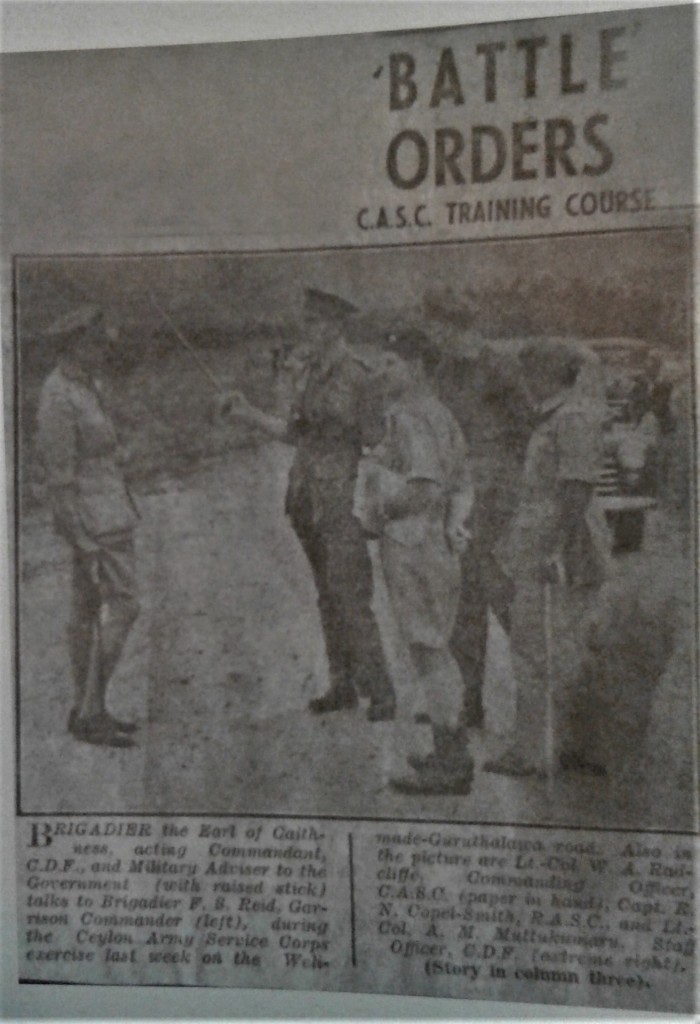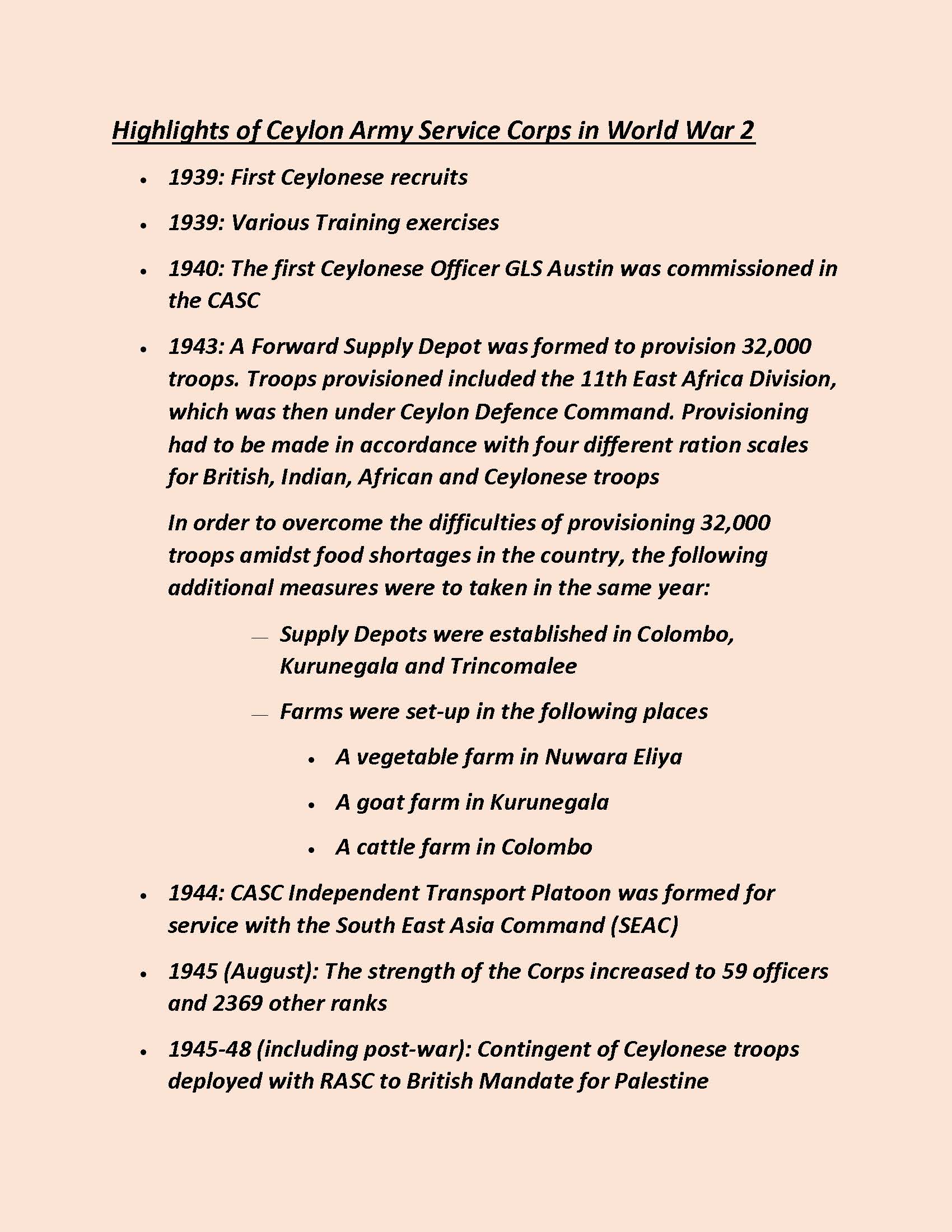
1939: Sinhalization of the Corps

See how the two march forward gracefully! The British Lion and Lankan Lion
British Recruiting Poster WW2
Fill high security zones in Ceylon with troops
Ceylon is your Motherland
Join the Army now. You will get the uniform you wish to wear. We’ll make you a new man
Starting in the middle of the nineteenth century, with the creation of numerous missionary schools and secular schools, Ceylon was producing growing numbers of Ceylonese to fill roles within the colonial administration, including in the army. In 1931, Ceylon had the distinction being one of the first countries in Asia to receive universal adult franchise. Another unique characteristic of Ceylon was its very high literacy rate. During the WW2, Ceylon had the highest literacy rate in Asia outside of Japan and Philippines, a figure which grew from 40% in 1921 to 57% by 1946.
Nevertheless, in Ceylon and in India, prejudice towards locals prevented the British from initially raising a native officer corps. In India, the exigencies of WW1 and the necessity of maintaining a large standing army compelled British authorities to create a native officer corps. The native officers in India were commissioned under what was known as a Viceroy’s Commission, which was subordinate to the King’s Commission. In Ceylon many of the Ceylonese were commissioned during the war years under emergency war commissions, Governor’s Commissions and King’s Commissions. At the formation of the Ceylon Army in 1949, those Ceylonese in British Regiments resigned their King’s commission before transfer to the Ceylon Army.

The CDF had Ceylonese represented in the officer corps, especially in the CLI and Medical Corps, during WW1. Early efforts at creating a native officer corps and soldiers were focused on English speaking Ceylonese. The process of “Ceylonisation” spanned several decades and included such notables as Sir John Kotelawala and Lt. Col. CAHP Jayawardena of the Ceylon Light Infantry.

Notable Sri Lankan Personalities in WW2:
Col. Sir John L. Kotelawala, Ceylon Light Infantry (Minister of Public Works in the Constitutional Council), and Lt. Col. CAHP Jayawardena, Ceylon Light Infantry (Conservator of Forests)

By 1938, with war clouds looming on the horizon and with the need to expand troop numbers rapidly, British authorities supplemented the the Ceylonization efforts with a mass mobilization effort which they referred to as “Sinhalization.” By this time regiments like the Ceylon Light Infantry and the Ceylon Medical Corps had majority Ceylonese representation in the officer corps. By contrast, the Ceylon Planters Rifle Corps and the Ceylon Army Service Corps had remained exclusively European. The 1938/39 Ceylonization and Sinhalization efforts opened up all regiments. The opening up of the CASC is described in the following dispatches to the RASC Journal in 1938.
Journal of the Royal Army Service Corps 1939 April (Page 237) “Owing to the reorganization following on the decision to Sinhalize the C.A.S.C., promotions amongst trained European personnel were made to fill vacancies in our new establishment and included the following: —
To Warrant Officer, Class II, 2;
To Staff-Sergeant and Sergeant, 23;
To Corporal, 24.
Congratulations are offered to all concerned.
Sinhalization of the Corps has been proceeding since we called for new recruits in October, 1938, and the first batch finished their probationary period in January. Several failed to reach the required standards, and twenty-four only were actually enrolled as members of the Corps on 3rd February.
The enrollment, being of historical interest, was the occasion of a large attendance at Headquarters, and the CO. took the opportunity of addressing the new members. Since then the number of Sinhalese members of the Corps has increased owing to transfers from other Ceylon Defence Force units and further enrollments. New recruits continue to be enrolled as they complete a satisfactory probationary period of three months, At present we have about fifty on probation.
The new Commandant, Ceylon Defence Force, Major (Local Col.) R. S. M”. White, O.B.E., The Leicestershire Regiment, has now arrived and assumed duty. All ranks extend a hearty welcome and trust his stay in Ceylon will be a pleasant one. Our Headquarters were visited by Col. White on 14th March, when he inspected our accommodation and met the Colombo officers. He also saw several quads of our Sinhalese recruits at their training. As a result of his visit, we are hoping that the
question of improved Headquarters will now be pushed forward, as the existing accommodation is very inadequate.
Certain changes in the ceremonial dress of the Ceylon Defence Force have recently been approved. These changes bring the Ceylon Defence Force into line with the Regular Army. The most important change is the abolition of breeches, puttees and field boots, and the substitution for them of trousers.
Some ten motor-cycles (Matchless) have recently been received by the Ceylon Defence Force, and passed to the C.A.S.C. for maintenance, running-in, etc. Opportunity is being taken to carry out their assembly by a class of Sinhalese recruits under the supervision of M.S.M. Maslin.”
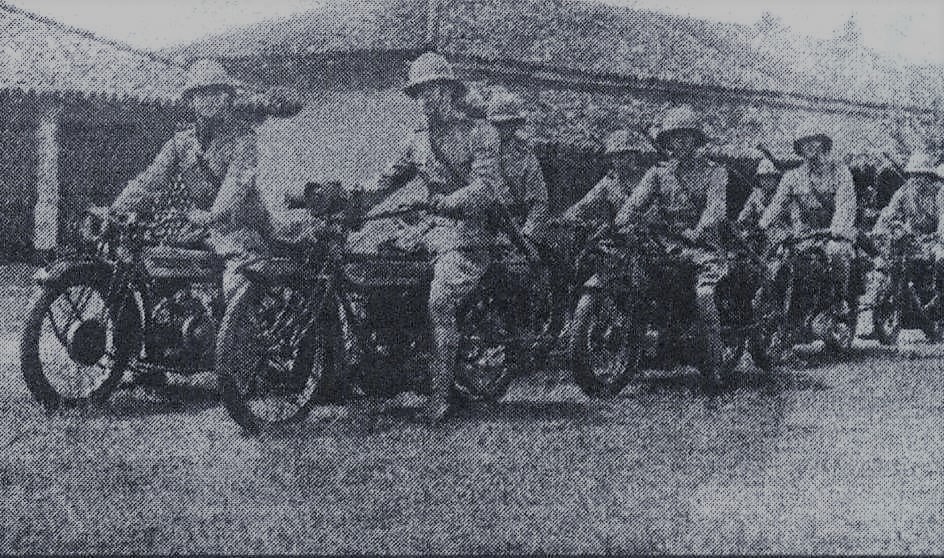
1939 February: Largest Training Exercise Ever Staged in Ceylon
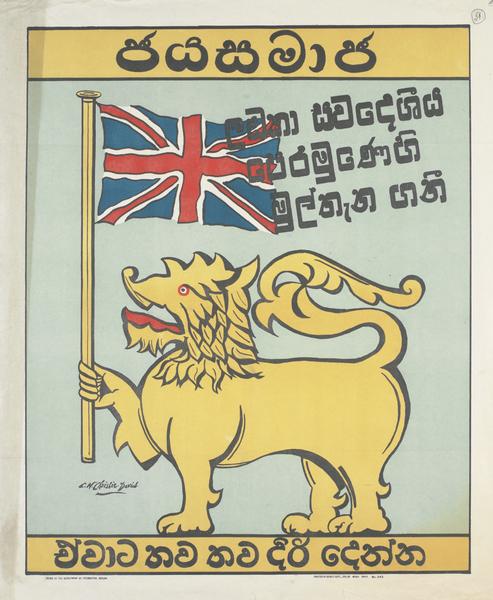
According to the RASC journal, the military exercise staged in Trincomalee in February 1939 was the single largest combined naval and military exercise ever staged in Ceylon. The RASC, which took the lead on logistics and transportation arrangements, did an immense amount of preliminary work. These include the provision of special trains between Colombo, Kandy, Diyatalawa and Trincomalee, provision of certain camp equipment, extra barrack equipment and the provision of many lorries and other forms of transport for use before, during and after the exercise. The passages below describe the CASC’s involvement in this exercise.
Sons of the Motherland Rally Around

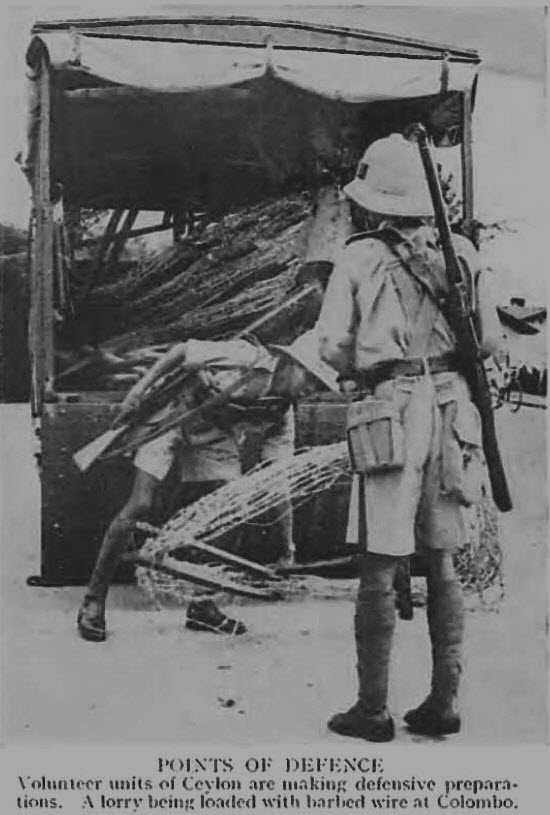
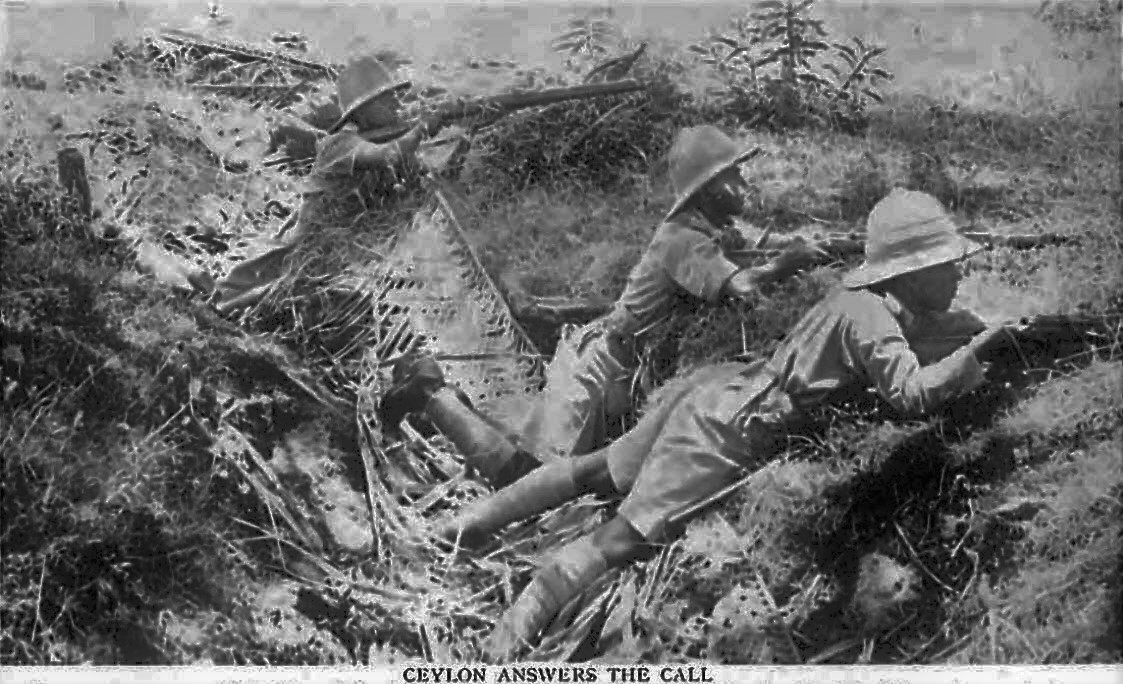

Journal of the Royal Army Service Corps 1939 April (Page 237) “On Friday, 17th February, a cadre of 2 S. & T. Coy., C.A.S.C, was mobilized at Colombo and left that night by the special troop train for Trincomalee to take part in the combined naval and- military exercise.
Capt. Kirk, O.C. 2 S. & T. Coy., ably assisted by Capt. Thomas, 2/Lieut. Paterson, R.S.M. Townsin and C.S.M. Black, was responsible for the entraining and detraining arrangements on both the outward and return journeys, and largely owing to the efficient manner in which the duty was carried out the outward train left Colombo some five minutes before time.
Altogether, twenty members of the Corps were required for duty at Trincomalee, and the selection of this number from those who wished to go was no easy task. At Trincomalee arrangements had been made to provide some fifteen lorries (with drivers) to carry out the troop-carrying functions of 2 Coy., so that the European personnel were required mainly in an administrative and supervising capacity.
Capt. Kirk, having established his Headquarters in the Rest-house (misnomer on this occasion), proceeded to put out detachments as required and arrange duties. We then waited for any call on our services. We had not long to wait and soon there was a succession of messages asking for transport to move troops in various directions. All requirements were quickly met, but it was forcibly borne in on us that other C.D.F. units had no idea as to how transport should be used economically. It was found, too, that where transport was sent out to infantry detachments for some specific duty, the unit concerned seemed to think it had a right to use it for other purposes. On one occasion a lorry was stopped and the N.C.O. in charge questioned as to where he was going. It transpired that it was bound for a detachment some distance away with a suitcase which had been left behind by its owner. This, with transport standing by to move troops at a moment’s notice! Some delay was caused at times by the absence of any knowledge of embussing and debussing by the troops carried. This has been strongly pointed out to C.D.F. Headquarters with a hope that units of the C.D.F. may have some instructions in that important drill. On the whole, the Corps has reason to be proud of its ability to meet the unexpected. On one occasion one of our other ranks assisted in routing a landing party at an outlying point by turning his headlamp on them, thereby giving the nearby machine-gun post an excellent target.
The exercise was not without its humorous incidents. On one occasion, while a lorry, halted by the roadside, was being unditched, a car drove up and stopped. The driver, a naval rating, came across to inquire what was the trouble, and was promptly put under arrest as a possible spy. Meantime, the R.S.M., who happened to be in charge of the unditching party, went across to the car, and when the occupant of the rear seat began to speak he was promptly ordered by the R.S.M. to be quiet and ” speak when you’re spoken to.” At this moment, the officer in charge of the military party, seeing the occupant of the car, saluted smartly and began to explain. The occupant of the car was the Naval C.-in-C. In another sector, about the same time, another member of the Corps, seeing two naval ratings on the road, questioned them as possible spies, and as their replies were not satisfactory they were bundled into a lorry and taken to Fortress Headquarters for interrogation. They turned out to be the Admiral’s wine steward and an underling at Admiralty House. We trust any guests at Admiralty House were not seriously incommoded.
The return journey of the C.D.F. by special trains to Colombo and Kandy and the R.A. to Diyatalawa was marred by the failure of the leading train to take the gradient at Maho. There was a delay of some hours while the railway authorities played a game of shuttlecock with the trains. As all the shunting was done in the early hours of the morning, there was little sleep for any of the 800 people in the trains, and many and varied were the alternative names coined for the Ceylon Government Railways that night. C.Q.M.S. Innes-Lillingston resigned from the Corps on 30th January after serving in it for fourteen years. He was a regular attendant at camps, and is in possession of medals bearing the heads of Her Majesty Queen Victoria and His Majesty King George VI.”
1939 March: 21st Anniversary of Ceylon Army Service Corps
Journal of the Royal Army Service Corps 1939 March
“We take this opportunity of conveying our sincere good wishes to all members of the Ceylon A.S.C. on the occasion of the 21st anniversary of the foundation of their Corps, which falls on 12th April next. Since its formation in 1918, our alliance with this Corps has been of a close and cordial nature, and it has been our pleasure to receive many of its members of all ranks, here at Corps Headquarters and elsewhere at home, at frequent intervals. It speaks highly of the keenness of the Ceylon A.S.C. when numbers of its members are prepared to sacrifice quite appreciable periods of their hardly earned and often too-infrequent home leave for the purpose of attending voluntary courses with· the R.A.S.C. at home.”
1939 April: CO’s Letter to RASC Journal
H.Q., CEYLON ARMY SERVICE CORPS,
SLAVE ISLAND,
COLOMBO, CEYLON.
25 April, 1939.
To the Editor of the ” R.A.S.C. Journal.”
Dear Sir,
Your very nice reference to the Ceylon Army Service Corps and its coming-of-age, which appeared in your April, 1939, issue, has given very much pleasure to all of us.
We are holding a special parade on the 27th inst. in connection with our coming-of-age, and I will then read out your generous reference to us. Our very cordial relations with our parent Corps are a source of real gratification to all members of the Ceylon Army Service Corps, and I personally am most grateful for all that the Corps Journal has done to cement these relations.
Yours faithfully,
C. J. DANE LANKTREE, Lieut.-Col. and Bt. Col.,
Commanding Ceylon Army Service Corps.
1939 May: The Calm Before the Storm

Journal of the Royal Army Service Corps 1939 May
“Following the arrival of the new Commandant, Ceylon Defence Force (Col. R.S.M. White, The Leicestershire Regt.), an intensive recruiting campaign was launched in order to bring the C.D.F. up to establishment. The campaign began with a broadcast talk by Col. White, and articles about the various units of the C.D.F. appeared in all the Ceylon newspapers. An article dealing with the C.A.S.C., its history, role, training, sport etc. was submitted and published in its turn. Although recruiting for the C.D.F. in general was in need of such a campaign, it must be mentioned that in the C.A.S.C. we had no difficulty in obtaining recruits to fill the vacancies in our new establishment. Up to date we have enrolled 72, and, with a further 31 now on probation we have more than enough to complete our establishment, together with the IO% over strength which is allowed.
At the laying of the foundation stone of the Drill Hall for the newly forming 2 A.A. Regt. C.G.A. on 1st July, it was announced that the recruiting situation was very satisfactory and that all Corps in the C.D.F. were now practically up to full strength. In addition, most Corps had already opened waiting lists.
COMING OF AGE.
The C.A.S.C. celebrated its “Coming of Age” at the end of April with due pomp and ceremony. A special parade was held at Headquarters in Colombo on 28th April at which the Corps was inspected, and later addressed, by the Commandant, C.D.F.
Major L. M. Mote, E.D., was in Command of the parade of 12 Officers, 21 W.Os. & N.C.Os., and 70 other ranks. The Commanding Officer, Colonel C. J. D. Lanktree, E.D., & Bt. Lt. Col. Murdoch, E.D., were present. After the Commandant’s address, messages of congratulation and good wishes were read out by the Commanding Officer. These included messages and telegrams from our Honorary Colonel, Field Marshal H.R.H. The Duke of Connaught; the Representative Colonel Commandant, R.A.S.C., and Lieut. Colonel E. B. Rowcroft, M.B.E. (the first Adjutant, Ceylon A.S.C.), and from our “Outstation” Detachments.
After the parade, an excellent smoking Concert was held in the C.P.R.C. Headquarters (which were generously loaned to us for the occasion).
The celebrations culminated in a Grand Ball & Cabaret Show, which was voted a huge success by one and all. Only a few people know what time the last revelers left. When the writer left-about 4 a.m.-fresh chalk was being put on the floor. The organizing committee put in a tremendous amount of hard work and richly deserve the thanks of all, who enjoyed the results of their labours.
CAMP.
Our annual Camp was held at Diyatalawa from 19th to 29th May, and was the most successful Camp so far, inasmuch as we had “numbers” to command. Actually there were in Camp 12 Officers, 16 W.O’s & N.C.O’s and about 60 other ranks. Our training was of a somewhat elementary nature owing to the number of newly joined members, and was largely confined to Driving Instruction, drill & weapon training. We did, however, have a few runs into the country on tactical exercises-which were enjoyable as well as, we hope, profitable. It is to be hoped that the convoy commander who forgot to make a short halt will in future remember that even though his vehicles may run for hours, his men may require to have an occasional halt.
An indoor T.E.W.T. for Officers and N.C.O’s was carried out, and (if the number of questions asked be a guide) was popular as well as instructive. This exercise was attended by the Commandant C.D.F. and the Commanding Officer.
A very excellent display of drill by a Detachment of Royal Marines from H.M.S. Manchester was thoroughly enjoyed by all ranks. The display included a demonstration “How not to drill” followed by “Drill” as it should be done.” The latter part of the demonstration left everyone silent with admiration; and on our own parades which followed, a very marked improvement was at once apparent. The Marines also gave us a demonstration of the new drill in threes. This has not yet been adopted by the C.D.F.
A very successful ceremonial parade was put on at very short notice for an inspection of the Corps by Captain H. H. Bousfield, R.N.
Brigadier J.0. Thurburn, M.C., Commanding Troops, Ceylon, paid us a visit during Camp and spent the day watching the Corps at their training.
He professed himself well satisfied with the progress made by our Ceylonese recruits.
On the last Friday night of Camp the usual Officers’ Guest night was followed by a Dance in the Sergeants’ Mess. The origin of this event is interesting.
Some years ago, in the early days of the Corps, the Officers were proposing to have a Ladies’ Night during Camp but could not decide on the actual programme. A certain member of the Sergeants’ Mess who happened to know that the Officers were undecided suggested that the Sergeants’ Mess should steal the Officers’ Ladies. The idea was immediately seized upon and envoys from the Sergeants’ Mess were sent secretly post haste to invite all the Officers’ wives, sisters and friends and all available and eligible ladies in the district to dine at their Mess and have a dance afterwards. The ladies all entered into the joke and kept the secret. The Officers were then invited to visit the Sergeants’ Mess after dinner on the appointed night and were, needless to say, some what surprised to find their ladies already enjoying themselves. The invitation for Officers ladies to dine with the Sergeants, followed by a Dance to which the Officers are invited, has now become a Regimental Custom.
Much regret was felt by all ranks that C.S.M.I. Johnston, our temporary P.S.I., was too ill to attend Camp. Our new P.S.I., C.S.M.I. Sidney, R.A.S.C., arrived from England just in time to attend Camp and was ably assisted by C.S.M.I. Ferrol, loaned to us by the Ceylon Light Infantry.
KING’s BIRTHDAY PARADE.
The Corps took part in the King’s birthday Parade held on the Galle Face on 8th June. This was the first public parade in which the Corps appeared since Ceylonised. It is a matter of Satisfaction to know that surprise was expressed in various quarters at the good turnout and soldierly bearing of the Corps on this occasion. Congratulations to Captain Kirk, who commanded the Corps on parade, and also to Captain Thomas and Lieuts. Jones and Paterson.
TRAINING.
Our main aim at the moment is to produce drivers, and all other training is of a secondary nature. Certain proposals have been submitted to C.D.F. H.Q. with a view to expediting this very urgent training, and are now under consideration. Should they be approved, our output of trained drivers will be greatly increased. . .
With a view to better co-operation between units of the C.D.F. and between the C.D.F. and the Regular garrison, a series of lectures has been arranged wherein lecturers from each unit will speak of the unit, its war role, and how other units can co-operate and assist in its carrying out that role. Two such lectures will be given by C.A.S.C. personnel during July.
PERSONALIA.
We regret to announce the death of Sergt. E. Jardine which occurred quite suddenly, at Kandy, on 26th April. He was a very keen member of the Corps and will be missed very much. He was given a Military funeral at Kandy, at which the Corps was fully represented, as well as other units of the C.D.F.
C.Q.M.S. S. H. Sidney, R.A.S.C., arrived in Colombo on 30th April and has resumed duties as P.S.I. after absence from Ceylon of 19 months. We wish him a happy tour of duty.
2/Lieut. W. D. Godsall returned to Ceylon from leave in the U.K. during which he attended two Courses of Instruction at Aldershot. Stout fellow!
We reproduce a typical letter from an applicant wishing to join the C.A.S.C.
RATNA NIVASA
Ratnapura
29-3-39
Sir,
In view of the fact that war clouds are gathering in on all sides and that our beloved king is hard put to it to protect his far flung dominions I beg to offer myself as a private in your unit.
In the event of war I shall earnestly desire that I be sent to the front where the fighting is thickest, that I may fight, and die if necessary, for the King, democracy, and freedom.
I am 30 years of age, unmarried, and am at present the Superintendent of an Estate in Pelmadulla.
If my humble services are accepted I shall always maintain the high traditions which are the heritage of a British soldier.
I am Sir
Your Obedient Servant
Sgd. W. K. M
CONGRATULATIONS
To Sergt. C. H. Todd on his very lucky escape from serious injury in a recent encounter with an insane cooly. May he have a speedy recovery.
To S.Q.M.S. C. B. Wratten and M.S.S. T. E. R. Smith, on their being awarded the Efficiency Medal. To Pte. Arnolda, on his success in the Ceylon Rifle Association Meet. We wish him and other Corps competitors better luck next year.
To those members of the Corps who won the prizes and trophies awarded for competitions held during Camp.
All ranks of the C.A.S.C. send best wishes to our youngest brother, the Singapore A.S.C. (V). ”
1941 August: Last War Time Dispatch of the RASC Journal
JOURNAL OF THE ROYAL ARMY SERVICE CORPS AUGUST 1941
“Despite the vicissitudes of war, the Corps in Ceylon is still going strong in actual fact, much stronger than ever before. We apologize for not having appeared in the JOURNAL for so long a period, but there are adequate excuses we could put forward you’ve heard ’em all before from most stations, anyway!……
The C.A.S.C. has become a very important part of the Ceylon Defence Force since the war and now functions throughout the island in all aspects of Corps duties. The late Commanding Officer and the Adjutant recently received awards. We congratulate them both on this well-merited recognition of their work with the Ceylon Defence Force in general and with the C.A.S.C. in particular.
The Sinhalese R.A.S.C. recruits are making a name for themselves on the hockey field, and Pte. Perera won the 100 Yards, 220 Yards and 440 Yards at a sports meeting. Well done, Ceylon! “
Commentary: This is the last war time dispatch of the RASC Journal regarding the CASC. On 10 October 1939, little more than one month after Britain entered WW2 on 2 September 1939,
CASC Personnel Changes in WW2
- Lt. Col. Lanktree was promoted to full Col and become part of the CDF reserve list
- 2-I-C Major Mott, was forced to resign his commission in 1942. The Medical Board had declared him as “Category E -Permanently Unfit”
- Lt.Col R Murdoch was brought back again as CO till 1943
- On 21 March 1940, the senior British NCOs of CASC, the Regimental Quarter Master Sergeant W. A. Radcliffe and two Regimental Sergeant Majors, were promoted to 2/Lts. Radcliffe would later come a Lt Col and the last British CO of CASC
- Several British officers resigned their commissions in the CDF and joined the RASC
- Starting in Nov 1940 onwards, the senior Ceylonese NCOs (GLS Austin, WLF Perera, A. Nanaykkara) were promoted to 2/Lts. Many of them had joined the army straight out of school and would later go on to become some of the first Ceylonese COs in the post-independent period.
1940 First Ceylonese Commissioned Officer of the Ceylon Army Service Corps
On 8 November 1940, GLS Austin became the first Ceylonese to become a Commissioned Officer. On 5 December 1940 he was posted to No. 2 S&T Company, CASC Trincomalee. On 8 January 1942, he received a promotion to temporary captain. He would later become the first Ceylonese Commanding Officer (1950 to 1954) of the CASC. GLS Austin had studied at Royal College.
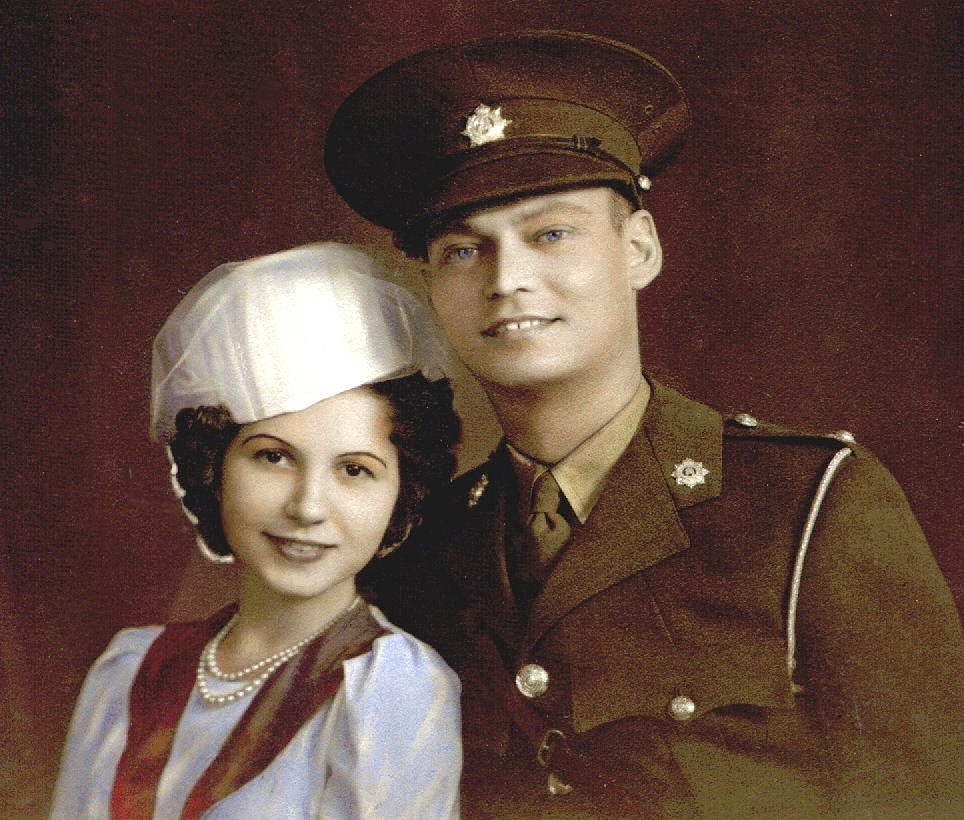
1942: Japanese Air Raids
..our Eastern fleet was powerless to protect Ceylon or Eastern India; our air strength was negligible; and it was becoming increasingly obvious that our small tired force in Burma was unlikely to be able to hold the enemy…
– Lord Louis Mountbatten, Supreme Allied Commander of the South East Asia Command
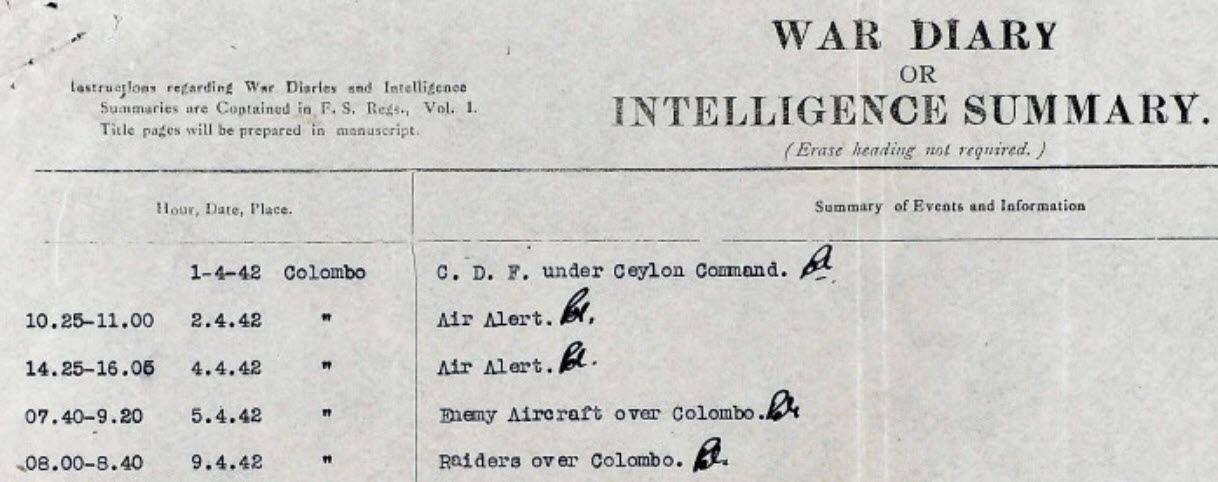
In 1942 the Japanese launched devastating attacks on Ceylon between April 4 and 9th which caused the loss of over 1000 British and allied forces. Despite the upbeat statement by the new C-I-C, the situation was dire, and the internal communications among top-level military leadership shows a different picture. In the aftermath of the raid, Mounbatten lamented that all of the British Blenheim bombers that had attempted to bomb the Japanese fleet had been shot down for no good reason.
1942: Japanese Footage of Air Raids (Click Link to See Film)
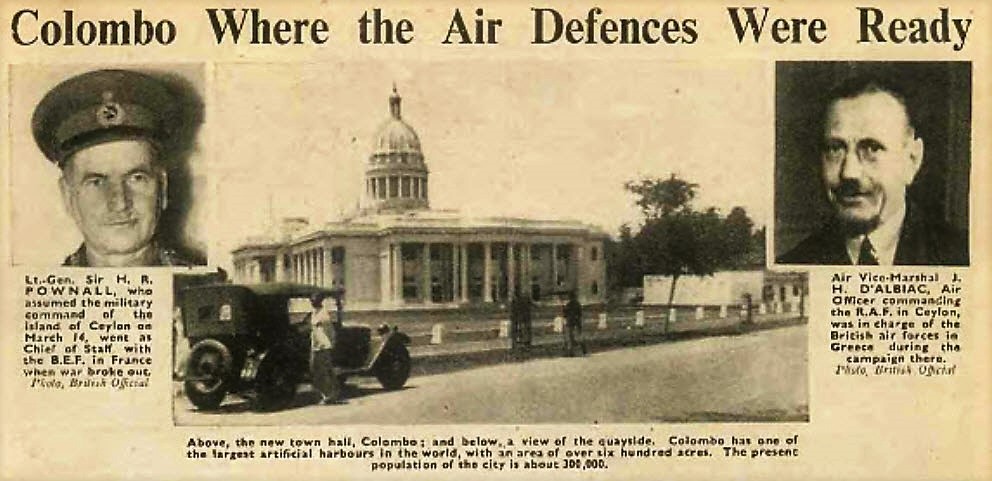

In the attempt to repeat their surprise attack on Pearl Harbour, the Japanese launched a heavy air raid on Colombo, British naval and airbase in Ceylon, on the morning of April 5. But this time the enemy found the defences ready, and of all the 75 raiders engaged 27 were destroyed and 25 others badly damaged.
Broadcasting from Colombo after the raid, Admiral Layton, C.-in.C, Ceylon referring to the Japanese losses, said: “It is a great piece of work, and I feel sure we shall join together in tendering our congratulations to the Air Vice-Marshal and his gallant officers and men who were responsible for this outstanding success.” Admiral Layton added : “It is not a matter of luck that we got off so lightly. It is entirely due to the manner in which we have prepared ourselves to meet this danger, and as long as we do not relax and continue to work together with a firm determination to succeed, we need have no fears as to the future.”
News Dispatch on the April 5, 1942 Japanese Raid
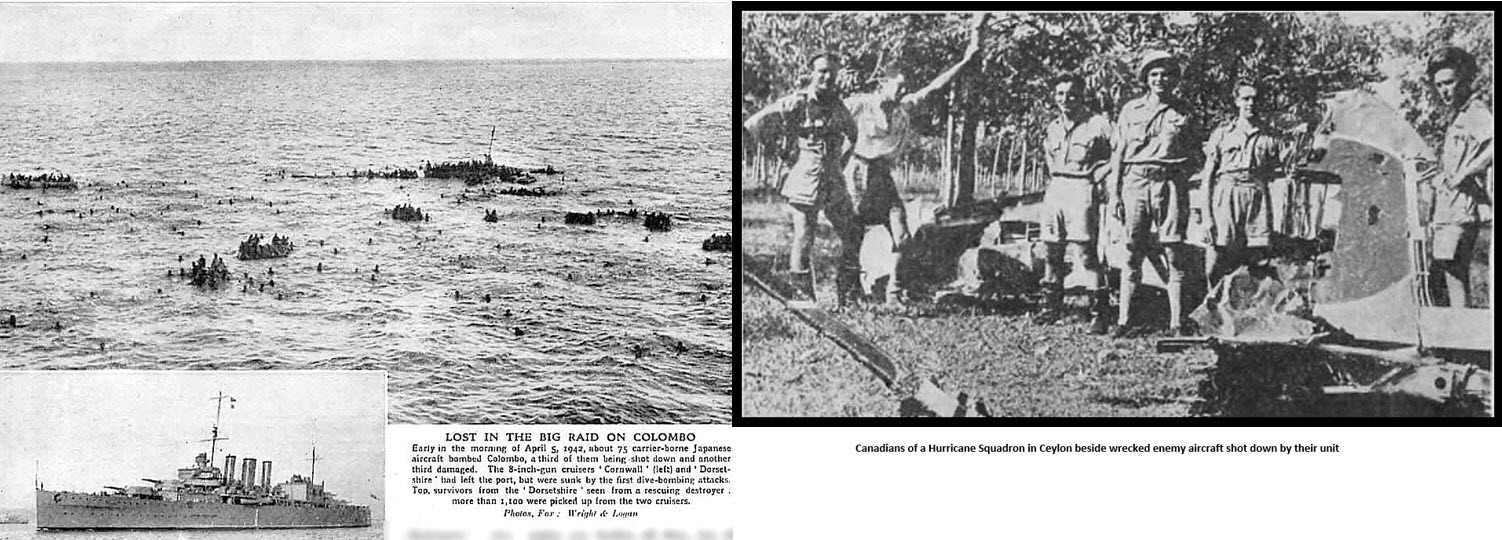
1943: Commanding Officer and officers of CASC

1943: Ceylon Garrison Artillery in Training (Click Link to See Film)

1943: CASC Provisioning the 11th East African Division
There were no active land operations in the Ceylon- Army Command during the period under review. The Japanese, however, carried out several air reconnaissances, and two of their aircraft were destroyed.
The arrival of the 11th East African Division was completed, and intensive training was carried out by this formation.
In August a new defence scheme for Ceylon was approved as a result of a re-appreciation of the role of the Army in that Command. It included the reorganisation of the garrison on the arrival of the East African Troops.
– British Dispatches June-Aug 1943
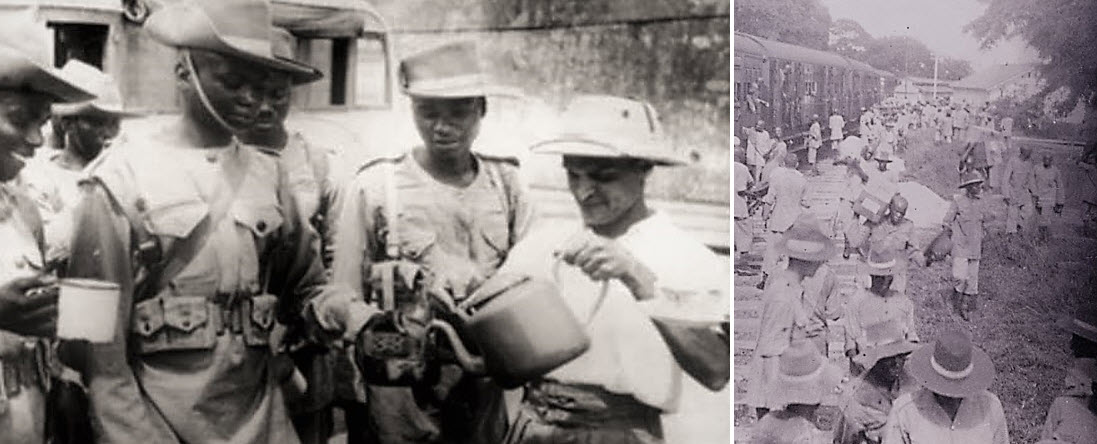
Left: East Africans learning jungle fighting in Ceylon Right: African troops in Anuradhapura
The arrival of the 11 East Africa Division in Ceylon and the role of CASC in provisioning this division was due to an unusual set of circumstances. By 1943, the biggest theater of operations of the South Asia Command was the Burma front. Most allied casualties in this theater were due to malaria. To overcome this situation, the British decided to deploy African troops who were thought to have a natural immunity to malaria. Furthermore, the idea of sending the East African division to Ceylon was intended to strengthen the precarious defence situation in Ceylon and to learn jungle fighting in the tropical environment of Ceylon. The Division arrived in Ceylon in June 1943 and left in June 1944 to Burma to join Indian XXXIII Corps. During its period of stay in Ceylon, it was under the Ceylon Defence Force command structure.
Additional Resources
The Forgotten War (Al Jazeera, 1 Sept 2011)
Films showing African troops learning jungle fighting in Ceylon
West African Troops on a Jungle Training Exercise (with Sound)
African Troops in Training Exercise in a Rubber Estate in Ceylon (no sound)

CASC’s challenge of provisioning 32,000 troops was compounded by food scarcities in the country. Ceylon with a population of six million would host 1.5 million Commonwealth troops. They came for Rest and Regrouping, and for Staging operations on the Burma front. The logistics of supplying the host troops and the local population was problematic due to the limited stocks of wheat received from Australia and the lack of sufficient rice stocks in the country. On 12th November 1942, the food situation prompted the Governor to send an urgent appeal to the Colonial Office in London. He informed London that rice stocks in the country were insufficient to meet the needs of the local population, and that additional stocks were urgently required from India. Although the amount requested by the Ceylon Governor was 1.5 % of India’s crop, at the time there were famine like conditions in parts of India. It is estimated that 2.1 million to 3 million people died in the Great Bengal famine of 1943, which changed the political landscape of British India and post-independent India.
To meet the exigencies of provisioning troops, CASC established three farms: a vegetable farm in Nuwara Eliya, a goat farm in Kurunegala, and a cattle farm in Colombo. Although there are no additional details regarding these endeavours, there are details concerning similar efforts at food production by the RASC in Ceylon.
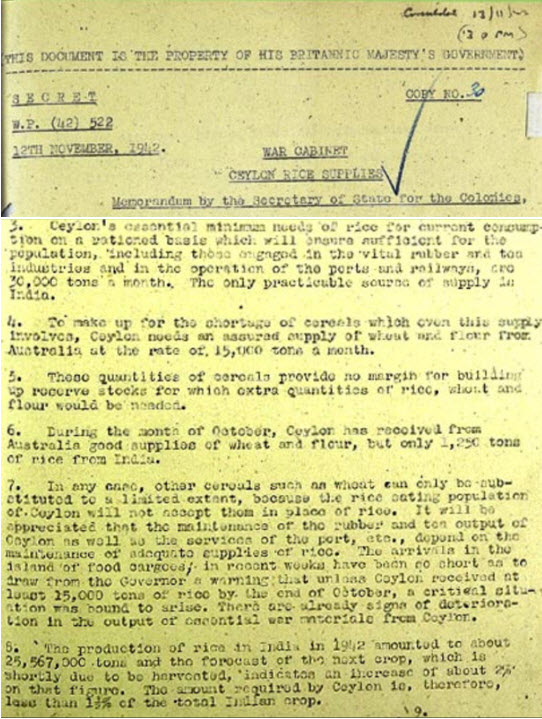
British War Cabinet Memo on the scarcity of rice in Ceylon, Dec 1942
1944: Visit of Major General Sir Reginald Kerr KBE CB MC, Director of Supplies and Transport at the War Office

1944 (July): South East Asia Command (SEAC) Headquarters Transferred From Delhi to Kandy


During this period the CASC Independent Transport Platoon was formed for service with the the South East Asia Command (SEAC). In addition, CLI troop detachments were stationed in Kandy in defence of the Supreme Commander Lord Mountbatten.

1943: Lt Gen Oliver Leese arriving in Colombo to take Command of Allied Land Forces under South East Asia Command (Click Link to See Film)

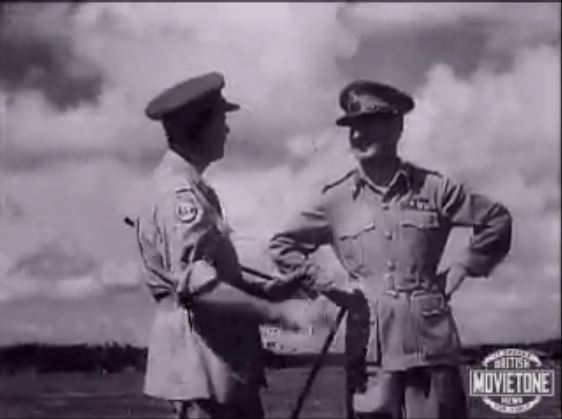
Left photo Lt. Gen. Leese and right photo Lt. Gen. Pownall (C-I-C Ceylon) and .Lt. Gen Wetherall (Deputy to Mountbatten)
1945 Victory over Japan (VJ Day)

1945 Sept 12: Video of Japanese Surrender to Lord Louis Mountbatten
1945 to 1948: Ceylonese Soldiers in Palestine

During WW2 most of the Ceylonese who served outside of Ceylon were in the RASC or in the Royal Engineers. This was an administrative necessity as the CDF’s theater of operations was limited to Ceylon, Cocos Island, and Diego Garcia. After the formation of the Ceylon Army in 1949 and leading up to 1952, all of the Ceylonese in the RASC transferred to the Ceylon Army.
Although technically the RASC was a different entity, the contributions of these Ceylonese who would subsequently become part of the Ceylon Army deserve attention.

During the period between 1945 to 1948, British Army records show that a number of Ceylonese were recipients of the General Service Medal for Service in Palestine 1945-1948.
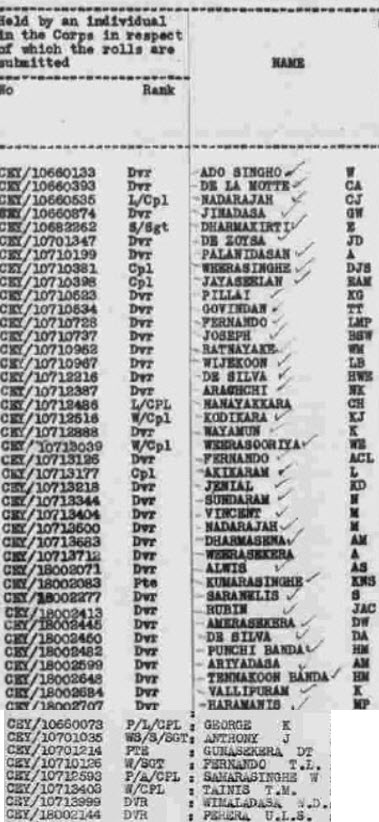
1947 May: Return to Peace Time Activities

1947 June 10: Troop Unrest Reported
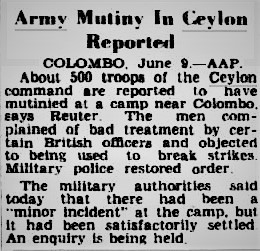
1949 Last Dispatch from RASC Journal from Ceylon

The British Empire ended faster than most people had anticipated. Although the British presence in post-independent Ceylon would continue in Trincomalee till 1956, the presence of the RASC appears to have ended in 1949, the same year that the Ceylon Army came into being. The following is the last dispatch from the RASC journalist in Ceylon dated 1949.
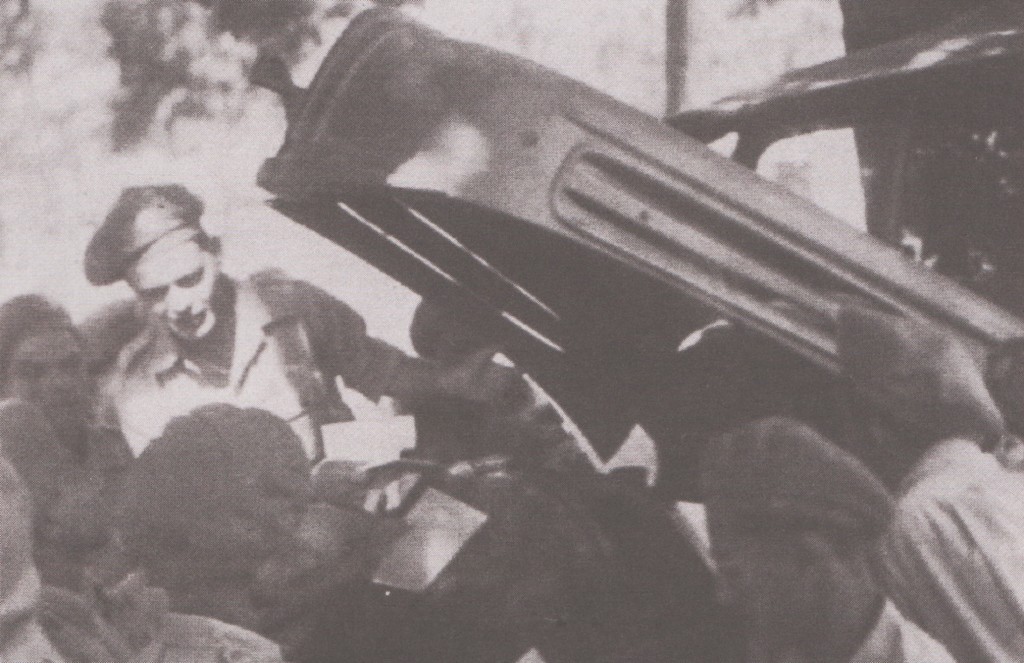
“We have been somewhat dilatory in reporting Corps life in Ceylon recently, but we are still here, British and Ceylonese, in fair strength. We number amongst our members many civilians who have been with us for thirty years and more. One, a daily paid (thus casual) labourer, has served with barracks since 1909, and the D.S.T., on his visit here last month, exclaimed on meeting him: “You’re an older soldier than I”—and saluted him—an occasion not likely to be forgotten in a country where they speak of Capt. Rowcroft as if he were here only last year and where faded Part I Orders (one dating back to 1897) can still be found. Some of the later entries were made in the youthful writing of our present civilian chief clerk.
The Director, on his visit, was indefatigable. Although only with us for thirty-six hours, he saw nearly all R.A.S.C. units and even inspected the Ceylon Army Service Corps—a splendid wholly voluntary force of Ceylonese, commanded by Lieut.-Colonel W. D. Raddiff, withwhom the R.A.S.C. have close and most friendly relations. Those of you who know Ceylon, and especially some of our most senior officers, will confirm what excellent material of intelligent soldiery there is here, and the C.A.S.C. is no exception. When the Ceylon Army comes into being very soon as a permanent defence force, they will be a most useful addition to our Commonwealth Defence Forces.
We are delighted to record that two out of three awards made in the past six months in Ceylon have gone to R.A.S.C. Warrant Officers —one a Ceylonese, S.Q.M.S. Rajadurai, a great all-round sportsman, and the other, C.S.M. R. F. Beer, whose small detachment in Trincomalee runs like clockwork, due to his tireless energy. To those of you who pass through these parts we extend a warm welcome. Please look us up as we are always glad to see members of the Corps.”

